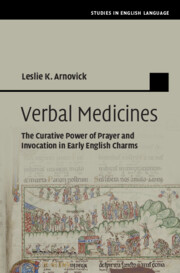Book contents
- Verbal Medicines
- Studies in English Language
- Verbal Medicines
- Copyright page
- Contents
- Figures
- Tables
- Introduction
- Chapter 1 Invoking Baptism
- Chapter 2 Psalm Charms as Aids against Illness
- Chapter 3 Invoking the Name of Mary
- Chapter 4 Invoking the Visitation of the Sick
- Chapter 5 The Multiplier Effect
- Chapter 6 Theoretical Implications
- Notes
- References
- Index
Introduction
Published online by Cambridge University Press: 29 November 2024
- Verbal Medicines
- Studies in English Language
- Verbal Medicines
- Copyright page
- Contents
- Figures
- Tables
- Introduction
- Chapter 1 Invoking Baptism
- Chapter 2 Psalm Charms as Aids against Illness
- Chapter 3 Invoking the Name of Mary
- Chapter 4 Invoking the Visitation of the Sick
- Chapter 5 The Multiplier Effect
- Chapter 6 Theoretical Implications
- Notes
- References
- Index
Summary
The Introduction begins by quoting a lengthy charm from Lacnunga and asks if there is rhyme and reason for its many formulas. It answers that question by establishing that comprehensive verbal strategies operate in early English charms. These take the form of unified sets of incantations that comprise the four verbal medicines identified in the book. Two involve the invocation of liturgy, a notion introduced here. The preface places folk tradition within the context of popular Christianity and considers charms as practical remedies for disease. Charm efficacy may be attributed to word-power, the skill of healers, prayer, and supplication. After examining Anglo-Saxon theories of disease the preface surveys what we know about medical practitioners at the time. It defines terminology, presents the corpus of charms, and summarizes methodology. Finally, it describes the performance-based analytical framework that will be used for the study of charms’ oral performance.
Keywords
- Type
- Chapter
- Information
- Verbal MedicinesThe Curative Power of Prayer and Invocation in Early English Charms, pp. 1 - 32Publisher: Cambridge University PressPrint publication year: 2024

